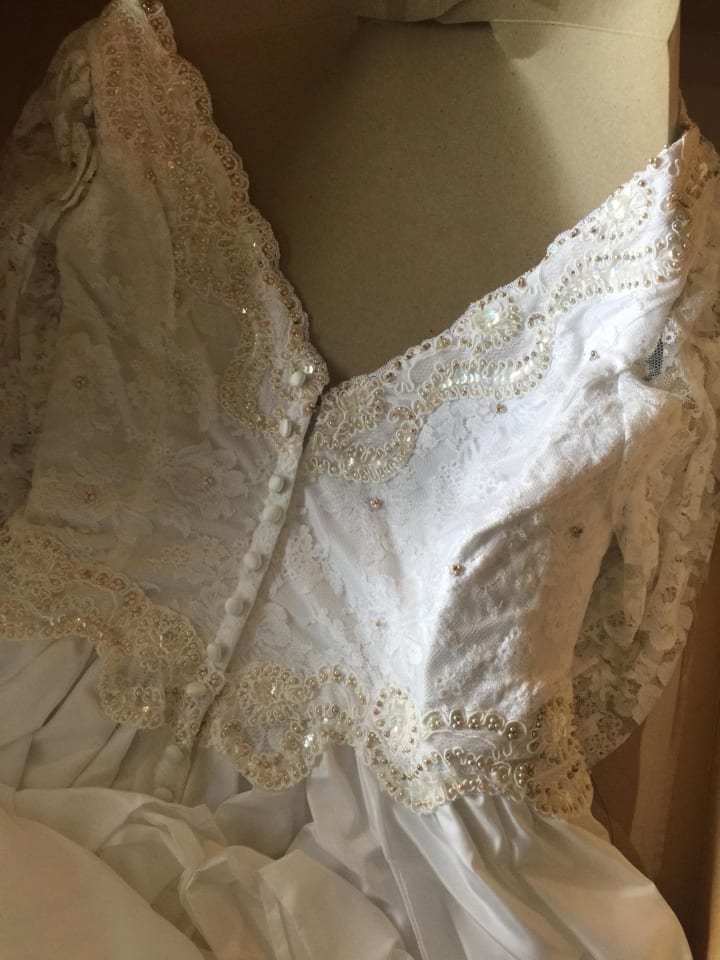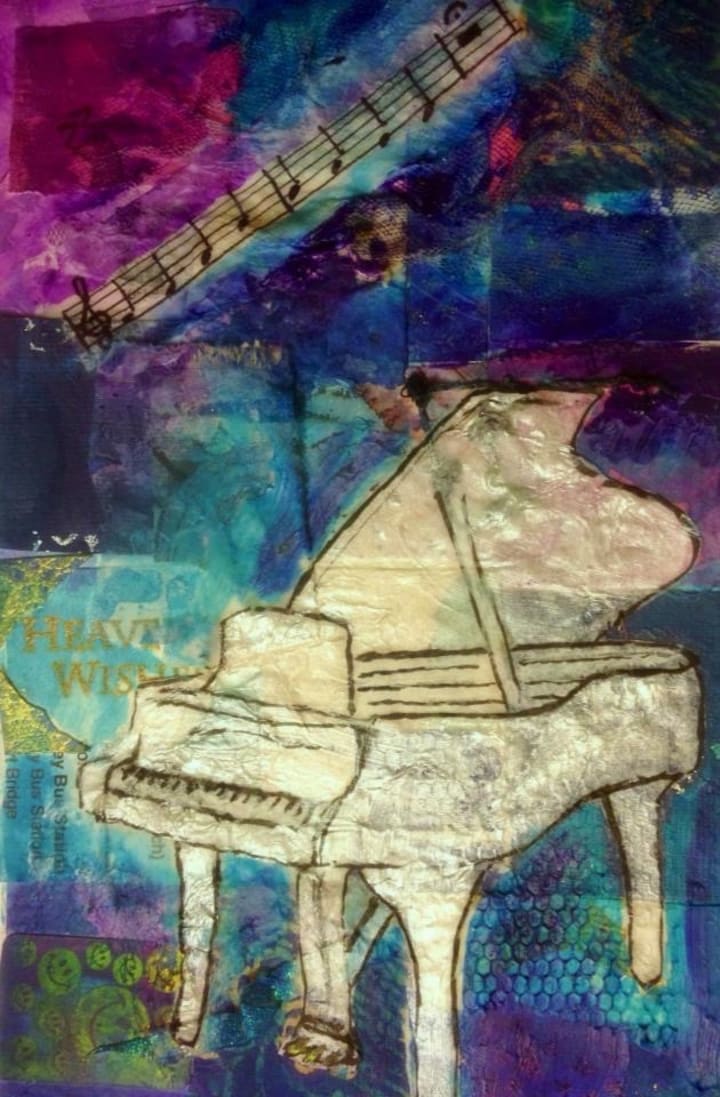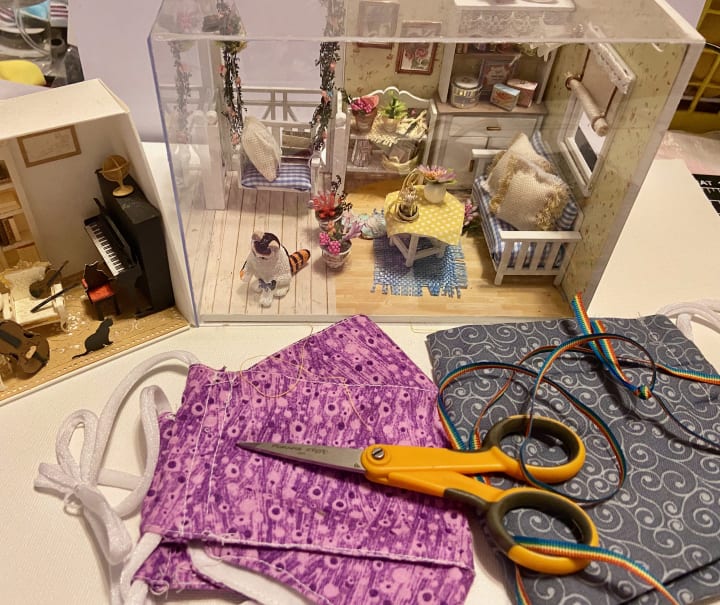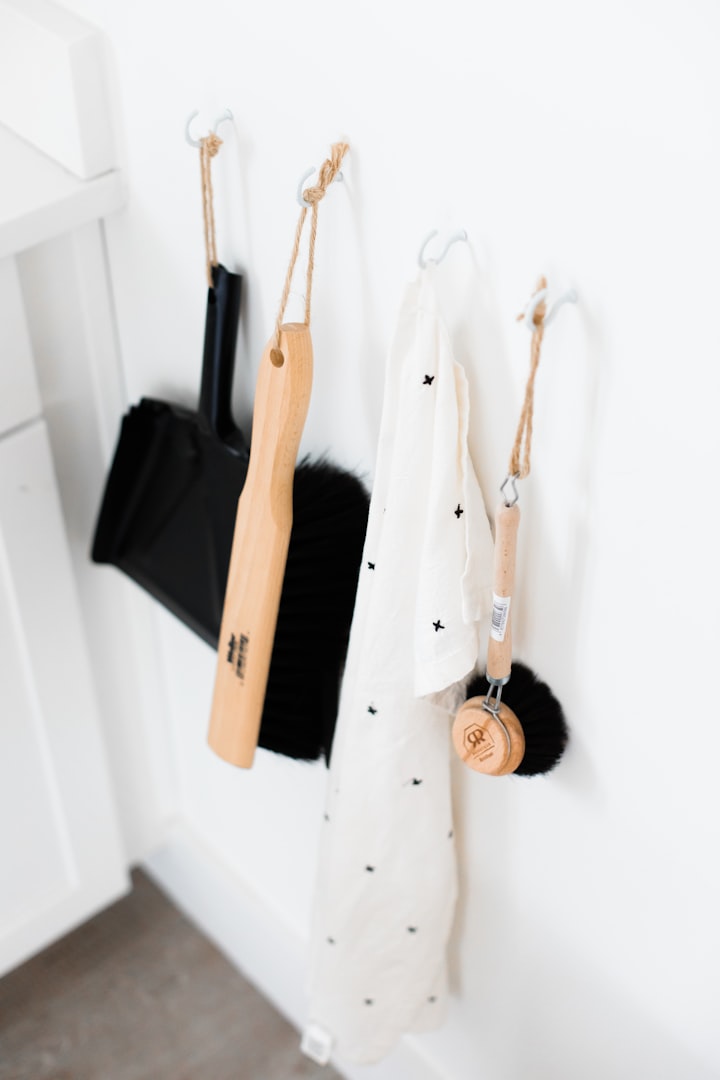Steering with Scissors: A social worker’s story
Navigating life’s journey using creativity to enhance the joys and cope with the challenges

King Arthur has Excalibur, Thor has his hammer, Glenda has her wand and Harold has his purple crayon. My superpower is using creativity in my journey through life’s hills and valleys, its twists and turns. And I have my scissors to help me accomplish that.
Who would have thought that a pair of scissors would be an instrument of inner peace and joy? Many of us have our tool kit of totems, amulets or special objects that help us navigate through challenges and mark significant events. In my personal kit is a pair of Fiskars scissors.
I have found that the process of creating, whether it be art, craft, sewing or music* can be one that facilitates mental health. It helps keep me in the present moment. It can make a sacred space where external events are “left outside the door”, or at least, knock first. I create to enhance celebrations or to help me with difficulties I had to learn to handle. For most of my creative endeavors, the one consistent item used is those scissors. *I guess one could say I have OCD and/or ADHD tendencies, since I want to try any creative process that is featured on my ”personalized” Facebook feed, following those links down a deep rabbit hole, but it’s a good thing that clinicians shouldn’t try to self-diagnose.
It wasn’t always easy being the eldest of just daughters with parents who were survivors of an occupied country during WWII. Mom was a psychologist (yes, it’s true, everything I said and did would be analyzed for a deeper meaning) and Dad a research scientist (sometimes what he was researching was secret, like when he was helping to invent things like satellites or the first desktop copier, plus it sounds better telling people that than saying my dad had a PhD in chemistry which, was one subject I struggled to learn). Frugality and knowing how to use existing resources were key to their survival during the war, and when they immigrated to the United States, they came only with few belongings. Even when our finances didn’t require making from scratch, I was raised to learn how to do so; these were considered essential core life skills. I was brought up to be a good Boy Girl Scout.(Why is it that only boys are supposed to always be prepared when everyone knows that it’s the moms who carry the diaper bags that contain something to handle every situation from poo to the apocalypse long after their children have graduated?) I began sewing and crocheting as a child, skills that were passed down from my grandmothers, and mother. I also helped my father with all of the household maintenance tasks, lawn mowing and cleaning out the dog kennel. (Cue in the Cinderella song.) When shop -now called tech -was offered to girls only two of us jumped at the chance. I ruined a homemade white voile dress painting a table I made in shop bright orange but won first prize in a contest for the table. The prize money was enough to buy more fabric, so it was a win-win in my mind. Since I was petite in stature, making my own maxi dresses made more sense than cutting off half the bottom of a purchased dress to make it fit. (If Randy Newman got paid for every time “Short People” was sung to me, he’d be a rich richer man.)
My husband and I met at grad school in a Master of Social Work program. After marriage and grad school loans, our growing family marked events by the making of baby blankets, christening gowns, holiday outfits, and costumes. In an attempt to be eco-conscious and thrifty, I also made cloth diapers and diaper covers. This was a major fail as it cost more to wash them multiple times than to buy disposables. Besides, who has time to hand rinse, pre-soak, wash and dry when one is chasing a little guy who found his big sister’s markers and decided to do his own version of Harold and the purple crayon in our house? That was during my earth-mother-wannabe phase when no store-bought preservative laden treat came into the house and everything I baked was with from whole grains and no sugar. This was cut short after I became a Girl Scout leader and Thin Mints re-entered my life. I even made one of my sister’s wedding gown. I bought my first pair of small Fiskars scissors then, to help detail cut the lace and sew tiny pearl beads onto gown, veil and reception hair bow piece. (I told you I could be a little OCD.)

In the late 1990s and early 2000s, I wanted to share the joy of creating by teaching beading and sewing to elementary students. My then second grade son, and his class learned about geometry when I taught them how hand sew small quilts from squares and triangular pieces of fabric. We managed to get through it with no major sewing injuries, and the perforated sprocket hole strips from dot-matrix printer paper (do a web search!) were perfect templates for helping the kids make straight even stitches. I taught kids in an afterschool program how create their own beaded designs and jewelry. I strung my Fiskars scissors on a colorful ribbon to wear around my neck, so it was always handy and readily identifiable as mine. I also made costumes for my daughter’s school theater program. If only spandex cowboy jeans were available; flips and dips in the dance scenes were brutal on regular clothes that our school theater budget could afford and modify into costumes. But, like Mary Poppins and her carpetbag, I too came prepared for those situations, with needle, thread and scissors.
On 9/11/2001, my mother was diagnosed with stage IV cancer. As our NYC region community dealt with the losses and trauma of that event, I stepped in to assist my father in the caregiving of my mom. There were medical appointments and hospital stays where waiting took hours. In order to keep anxiety from overwhelming me, I put together a pouch with beading projects and tools with me to work on during those times, the Fiskars tucked in there. The spring weekend that she died in 2002 was my daughter’s school show dress rehearsal, for which I was doing costumes. People questioned our presence at the rehearsals but being around vibrant teens who were having the time of their lives singing and dancing in costumes I had helped create, brought solace to my aching heart.
Later that year, I made a career change to teaching family and consumer sciences (FACS), formerly known as home economics in an inner-city school district that was still reeling from 9/11 while also dealing with escalating gang related issues. While FACS is considered an expendable course subject, I believe we taught essential life skills such as home resource management, decision making, cooking and of course, sewing. Once a social worker, always a social worker, and I found myself using those skills in the classroom. As students learned to cut pattern pieces and hand sew them into pillows, inevitably they would also want to talk. With little effort, the conversation could be directed towards sharing personal experiences and ways to handle challenges – also known as learning appropriate social interactions and problem solving. Yes, there were times of TMI, where some brave or very naïve student would bring up unanswered questions. Why does most of the educational information about reproduction address everything except intercourse, since it is also what many parents don’t want to go into detail explaining to their kid? No worries, save that question for the health teacher. You’d think teens would be better at avoiding sewing injuries than an 8 year old due to better developed coordination, alas more than one student literally became one with the sewing project. Students who were considered behavioral challenges or were used to handling disagreements through fighting (sometimes in gang groups) began coming to my classroom when they were tossed out of their class, or after school to work out their disputes in more peaceful ways. Somewhere during this time period, my original pair of Fiskars went missing. But while scissors can be replaced, human lives cannot, and I was honored that they felt I was an adult they could trust to help them navigate life.
I returned to social work a few years later because of educator training requirements which I could not fulfill within the required time period. I was working full time, taking the equivalent of almost full-time course work and trying to be a good mom as well. Yeah, my creativity superpower was definitely on overload. I get you Thor! While this was a disappointment, I could focus on my family and learn new creative skills such as mixed media and embroidery.

While I finally downsized from carrying bags that could hold a month’s worth of anything one might need (that bag was now in my car trunk, as my chiropractor started weighing my purse at the start of my appointments), I still found it useful to have ready-to-go pouches filled with supplies and UFOs * of the non-extraterrestrial kind. *Makers have their own language intended to downplay our stashes, justify spending money on or saving for the next new project and keep from being officially diagnosed as hoarders: UFO is an unfinished object aka last year’s project started but never completed. Frogging is what happens when a knitter or crocheter discovers a critical missed stitch six rows and two weeks back, so the piece is unraveled back to the mistake, and set aside as a UFO to complete in three months. Ephemera are all those things everyone else recycles or trashes but will someday be turned into a magnificent work of art or UFO. Supplies means all those specialized tools needed for a specific craft - like the weeder which looks like a dental hygienist’s plaque remover and is used with the vinyl cutting machine. But after giving up trying remove the tiny bits of vinyl from the sticky cutting plate, the weeder could never be repurposed for teeth cleaning or as a lobster meat pick. Or the candle wicks and wax when I thought homemade candles would make great holiday gifts but decided to make orange marmalade instead, after it took three hours to took to dip one tiny birthday cake sized candle. However, I realized after making the marmalade that the candle wax wasn’t food safe and couldn’t be used for sealing the jam.

A decade later, my dad and his sister died from cancer within a month of each other. My anti-anxiety treatment was again to channel my fears and worries into creating. My ready-to-go pouch with embroidery supplies came into use again the few years prior to their deaths. I once more found myself with my dad in waiting rooms and hospitals for long stretches. At home, I made mixed media pieces that were part prayer, part meditation, part safe happy haven. These mixed media works, which incorporated words, images, ephemera and paint were hung in my house to help create an environmental atmosphere of calmness and strength when I was struggling to cope. (I told you that ephemera would be useful someday!)

I worked with people with intellectual and developmental disabilities (IDD) for most of my social work career. Like working with children, working with people with IDD can be one’s Yodas if they were given the space to express themselves honestly. I learned essential life skills from them such as forgiving the mean people, breaking tasks down into manageable steps and respecting others who were different from me. My last job before retirement was as a supervisor with the NY State Office for People with Developmental Disabilities (OPWDD). Our department assisted people with IDD to access services and supports needed to help them live as independently and successfully as possible. Again, our region was hit hard last year as the epicenter of the COVID 19 pandemic in NY. People with IDD were not only at high risk, the supports they needed were also significantly impacted. For months, I was the only person working in our department, the rest had been furloughed as part of the mandated quarantine. Like many others, working from home most of the time meant I could roll out of bed and start my workday in my PJs. I finally understood another bit of wisdom from people with IDD: there’s nothing really wrong if you don’t wash your face twice a day or wear the same pair of pants a few days in a row. Nonetheless, I bought 5 of the same bargain sweatshirt in different colors so no one would say during zoom meetings that I was wearing the same clothes the whole week. When I had time to take a break, I looked to creating as my solace and making a space of inner peace. I sewed masks for family and friends and built miniature rooms. Working with miniature rooms requires focus and there is satisfaction in creating a stable structure cut from bits of paper, cloth and wood that are glued together. It represented what I hoped would be the rebuilding and creating of new ways of living in health and harmony. Yet again, my trusty scissors were present to help me cope, satisfy the OCD need to delve into intricate non work-related projects, and think about something else besides the turmoil in the world.

As the world begins to open up from COVID19 restraints, here are some ways that can help channel creative energy towards mental and emotional health:
- Exercise your “maker muscles” regularly. Even if you have only a few minutes, break down projects into smaller doable steps and allow yourself to fully focus on what you’re doing. Other chores will not get done by having your mind in one place and your body in another unless you’re an enlightened being, in which case you won’t be worrying about things.
- We’ve all had to learn what our personal boundaries standards are during COVID, but we may not know what our family and friends feel comfortable with. I heard of one clever bride who had color coded bracelets made for her wedding guests – green means “I would love a hug!”, yellow means “ask me before you touch me”, red means “I’m still not comfortable getting up close and personal”. Consider using your creative skills to make something like those bracelets (or pins) for your reuniting gatherings to help ease the stress of having to use your mind reading talent to determine other people’s comfort levels.
- I make and collect rosaries and prayer beads from my travels to different countries. They are my adult version of a fidget toy, and I hold them when I am out in public and not feeling at ease. Worry dolls and stones can be used similarly. Making something small and unobtrusive that is soothing for you can help you ease back into the world. No pocket play though, don’t want people to think you’ve totally forgotten how to act in public.
- Keep a small project without a completion deadline or that UFO from 20 years ago along with the tools you need to work on, in a pouch that you can grab when you’re going somewhere and may have to wait or traveling. If you’re a “I love to do all crafts” kind of person like me, you’ll have ones for knitting, crochet, sketching and watercoloring, and for journaling. You may need to buy a new set of shelves for these, but at least you're organized. These ready-to-go kits are perfect for packing with those almost used up items or second- string-now-that-you’ve-upgraded tools. I have trouble focusing on reading when I’m stressed and left my e-readers behind in places multiple times (like the pocket in the airplane seat in Brussels), but creative tasks engage multiple senses and do better at taking my mind off the stressors. A bonus is that if I accidently leave a UFO somewhere I can say I'm done with it.
- Look for ways to create commemorative tokens of gatherings that can be shared with the others. While this may have seemed cheesy in the past, for many of us, these “first get togethers” after quarantine have special meanings in many ways. These tokens can be symbols of fellowship, reuniting, resilience, and even loss. They have to potential to help anchor us back in hope. We had an extended family reunion and we each received a medal with the family name and date engraved. We wore them all weekend and for our group photos, but afterwards most of us tucked them away in our junk drawers. Little did we know that within the year, several family members would die. These goofy camp prize medals became a special token commemorating our last time together as a complete family. (No, I'm not still wearing mine but it's safe in my junk drawer.)
- Sip and Paint parties are popular because they allow people to get together and talk while they are creating. My students liked sewing projects, sans wine, for the same reason. If you struggle with having meaningful conversations with a specific person and are meeting up for the first time in a while, consider a creative or repair task that allows you two to work together. The conversations may flow easier and even if they don’t, the pauses are less awkward since you’re completing something together, especially if the joint task is one of your UFOs. It does help if you leave your bossy pants in your dresser though.
- Many people find journaling is helpful, whether it be just writing, or mixed media. I look back on older entries and realize that I am changing and growing in positive productive ways. It also alerts me to patterns that I may need to get assistance to change. When I’ve been journaling for five years about how our cat thinks it’s fine to sit on the dining room table next to me during meals, it's time for me to hire a cat whisperer.
If you have excessive fear or sadness that lasts, extreme mood changes, thoughts of suicide or harming others, please reach out to a qualified clinician or clergy for help. Professional training in the past year has focused on helping people deal with the additional traumas experienced in this extraordinary time. Many community health and human service organizations have also collaborated to gather resource options for the members of their communities. In the United States, The National Alliance of Mental Illness (nami.org) has a help line 1-800-950-6264 and 24/7 crisis counseling - text NAMI to 741741 in addition to online guidance and resources for people struggling with mental health issues for themselves or loved ones. Suicide prevention hotlines in the USA are: 800-273-8255 (general), 1-877-565-8860 for transgender community, 1-866-488-7386 for LGBTQ youth, and 1-800-273-8255 press 1, for the veterans’ crisis line.
I retired a few months ago so I could work on learning to destash. The creative expressions (just in smaller amounts that don’t take up three rooms) possible with the help of my dependable scissors over the course of a lifetime continue to be a source of joy and inner peace. And because I believe that the day I stop learning and creating is the day I die, I keep exploring new ways to express myself artistically. That small pair of Fiskars will be with me as I continue my journey through life, helping me create joy for myself and others and manage the challenges.
About the Creator
Beth Imperial-Rogers
Social worker, teacher, maker of all sorts





Comments
There are no comments for this story
Be the first to respond and start the conversation.